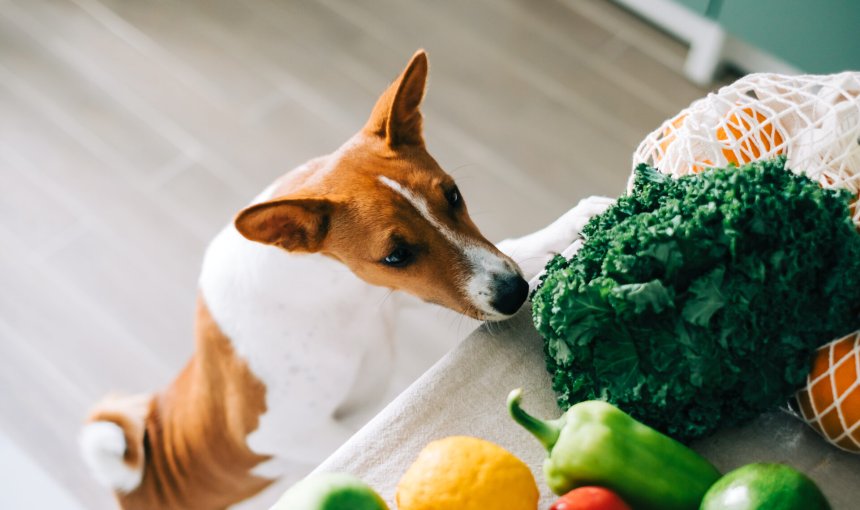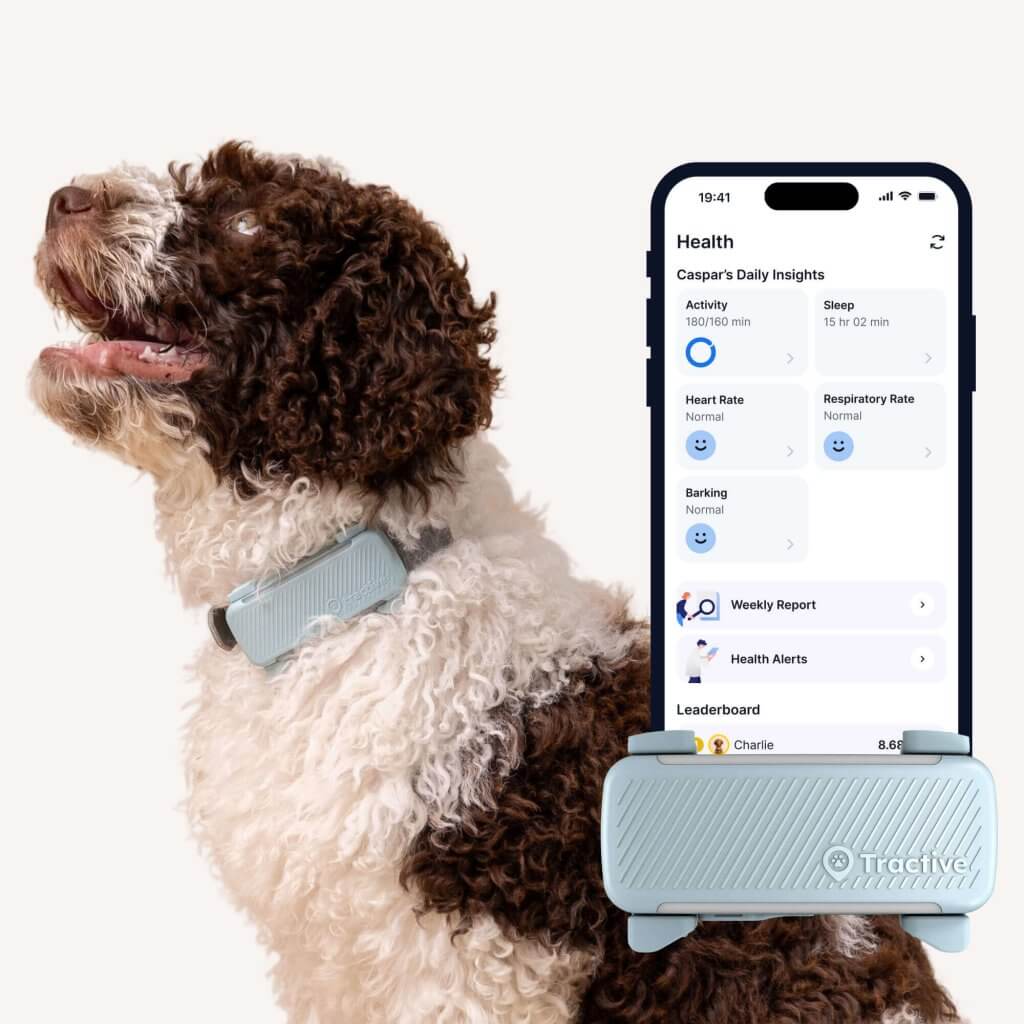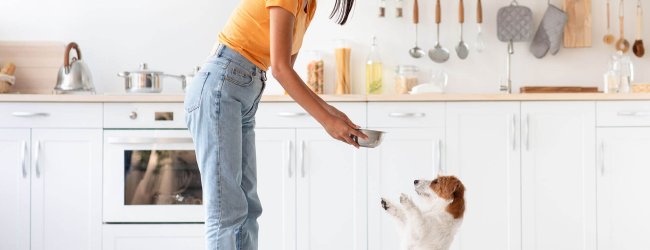 Approved by Dr. Dwight Alleyne, DVM
Approved by Dr. Dwight Alleyne, DVM 10 Of The Best Vegetables For Dogs & How To Prep Them
A healthy dog's diet includes vegetables too! Find out which vegetables are safe for dogs and which you're better off avoiding to keep your dog healthy. (Plus how to prevent them from getting "fed" elsewhere.)

With dogs being omnivores, they can safely eat a whole bunch of greens and veggies – but the question being, which ones? What are the best vegetables for dogs – and which ones should be off-limits? In this article, we’ll show you which healthy vegetables to add to your dog’s diet – the ones that help your furry friend thrive – plus which vegetables are dangerous for dogs. No more having to wander around the grocery aisle wondering what to buy!

Always know your buddy is healthy & safe
Read moreIs it okay to feed my dog vegetables?
Yes, of course! Dogs eating vegetables is nothing new. Before commercial dog food became available, a domestic dog’s diet was very similar to that of their two-legged companions. For many years, dogs survived by hunting and scavenging – eating the food scraps of the humans they lived with. As a result, dogs are very well equipped to digest starches – such as rice and potatoes¹.
The fiber, vitamins, and carbohydrates found in vegetables play an important role in a healthy dog diet. However, some are not recommended for dogs, and can be toxic, poisonous, or hard to digest. The latter of which can lead to a sick dog – and a pool of vomit on your new carpet (at best)…or an emergency trip to the vet (at worst.)
Vegetables for dogs: What do I need to be consider?
There are many different opinions about what you can and cannot feed your four-legged friend. Plus, every dog has their own tastes and preferences.
As a loving dog parent, we recommend only feeding your darling what they can safely and comfortably consume without painful side effects. If you suspect a certain food is making your dog gassy or causing other unpleasant symptoms, seek veterinary advice.
We also recommend the following do’s and don’ts when feeding your dog vegetables:
✅Dos
- Make vegetables the main component of the meal.
- Always add a source of fat to the vegetable mash (like oil, yogurt or eggs) so that your dog can also absorb fat-soluble nutrients like vitamin E, D, K and A.
- Use organic, local produce when possible.
- Feed ripe or even over-ripe vegetables.
- Aim for variety in your dog’s food bowl.
⚠️ We’d also strongly recommend you monitor your dog if they’re in the kitchen with you. Some tend to be more food-motivated than others – and can wipe out a fallen bit of food faster than you can blink!
🚫Don’ts
- Don’t let your dog eat the pit of any fruit or vegetable – these can be toxic if swallowed.
- Don’t feed your dog raw potatoes, broccoli, or other hard vegetables.
- Don’t leave your dog unsupervised in your kitchen or anywhere where food is involved!
⚠️ Besides monitoring your dog, we’d also recommend keeping your friends and family members in the know. There’s always the chance they might fall for the old puppy eyes trick or try and palm off some unwanted veggies off their plates to your dog. (And potentially poison them by accident.)

Get health alerts for your dog
Our pups can’t always tell us if something’s wrong. But if their tracker detects unusual changes in their routine, you’ll get an alert, helping you catch potential issues early.
How should you feed vegetables to your dog?
Vegetables for dogs should always be mashed, and lightly cooked (ideally in a puree) if possible. This is the best way for dogs to absorb the vitamins and nutrients in them. If your dog is healthy, you can feed them a raw fruit and vegetable mash – but be sure to check the guidelines below and consider which raw foods should never be given to dogs.
As always, make sure to double-check with your vet what vegetables are good for dogs – and whether they’re a good fit for your buddy.
What vegetables are good for dogs?
With this list, you can plan your next grocery trip, stress-free. Here are a couple of the best vegetables for dogs – and how you should ideally serve them.
Broccoli
Broccoli is delicious (yes, it is!) and can boost your dog’s immunity. Steam and puree some and feed it in small amounts to your dog.
- Try to always combine it with food that’s rich in calcium, like yogurt or cottage cheese. This way, your dog can absorb all the awesome nutrients in broccoli.
- Just be careful – broccoli florets (the top bits we humans love) contain a substance which can be dangerous for dogs.
- So only serve your dog cooked broccoli stems, and serve in moderation.
Brussel Sprouts
Another safe vegetable for dogs is brussel sprouts. They contain vitamin C and A, manganese, and fiber. Just make sure not to feed your dog too many brussel sprouts, because it can lead to flatulence. In other words, stinky farts and sad tummies. Not fun for anyone!
Carrots
Carrots are very dog-friendly and can be fed raw, grated, boiled or steamed. They provide your dog with a large portion of beta-carotene, which has a positive effect on eyes, skin and hair. What’s more, carrots can help clean your dog’s teeth and freshen their breath. They’re also high in fiber and vitamin A.
Read more: Dog Dental Care: How To Get Your Dog The Best Smile Ever
Celery
Celery is safe for dogs to eat – it is low in calories and contains vitamin A, B and C, plus phosphorus.
- Some nutrients found in celery may even support heart health and fight cancer.
- Like with carrots, celery can also help freshen up your dog’s breath.
Cucumber
Cucumber is the ideal snack food to help dogs lose weight or stay in shape. Containing little to no carbs or fats, cucumbers are full of vitamin C, K and B1, plus potassium, magnesium, biotin and copper.
Green Beans
Green beans in any form – raw, canned, steamed, chopped – all make for a great addition to your dog’s diet. Make sure your dog gets only plain green beans – no salt, spices or anything fancy. Green beans are low in calories yet high in nutrients, minerals, and fiber. In summary, a goodness-packed treat.
Peas
Peas, such as snow peas, green peas, or sugar snap peas, are safe for dogs to eat. Rich in several vitamins and minerals, plus protein and fiber, peas make a healthy addition to your dog’s normal diet.
Potatoes
Boiled potatoes provide your four-legged friend with a lot of fiber, vitamins and minerals and are also very easy to digest.
Pumpkin
Pumpkin, in addition to being high in fiber, can be helpful in treating dog diarrhea and constipation. Feed your dog cooked and chopped or pureed pumpkin, making sure that is is plain – not mixed with spices.
Sweet Potato
Sweet and delicious, sweet potatoes are a safe treat your dog will love. Be sure to cook sweet potatoes before feeding them to your dog. With a high fiber content, sweet potatoes in your dog’s diet can contribute to a healthy digestive system.
Now that you know what vegetables are good for dogs, let’s look which vegetables should not be fed to dogs.
Which vegetables are NOT safe for dogs?
Under no circumstances should you feed your dog the following fruits or vegetables, as they may be harmful to your furry friend:
- Onion and garlic – may destroy a dog’s red blood cells.
- Avocado – may causing breathing problems, sickness and diarrhea in dogs.
- Eggplant – best to avoid if your dog suffers from allergies or inflammation.
- Raw potatoes – contain solanine, which is toxic for dogs.
- Green tomatoes – may damage nervous system, kidneys or digestive tract.
- Grapes – can cause kidney damage.
- Rhubarb – can damage nervous system, kidneys or digestive tract.
- Persimmon – can cause diarrhea and fever.
Now it’s important to note – these foods aren’t just toxic to dogs in their raw form, but rather anywhere you find them. (Including in salads, pizzas, and more – where they might not only be available in small amounts.) So make sure to monitor your dog:
- When they’re in your kitchen
- When someone else might be feeding them (like if you’re on vacation)
- If they’re in the habit of wandering around outdoors (and getting “fed” elsewhere)…especially somewhere they could pick up something dirty, infectious, or potentially allergy-inducing
Because in the worst case scenario, even just a bite, lick, or taste of these ingredients might end up with your dog in the hospital – and you with a hefty vet bill you could’ve avoided otherwise.
Your furry friend’s health and wellbeing means as much as to us as it does to you. So we’ve made it a priority to only share medically-relevant content on our blog. This post was checked, double-checked, and medically verified by Georgia-based vet, Dr. Dwight Alleyne.

Dr. Dwight Alleyne, DVM
Originally from Long Island, New York, Dr. Alleyne began his career at a no-kill animal shelter before becoming a licensed veterinary technician. He graduated from Cornell University Veterinary College in 2006 and completed an internship at Purdue University. Now practicing in Georgia, Dr. Alleyne specializes in soft tissue surgery and ultrasounds. He also writes pet health articles on his website, “The Animal Doctor Blog” (www.anmldrblog.com).



